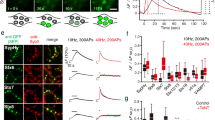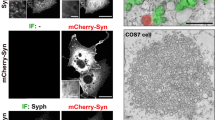Abstract
Upon exocytosis, synaptic vesicle proteins are released into the plasma membrane and have to be retrieved by compensatory endocytosis. When green fluorescent protein–labeled versions of the vesicle proteins synaptobrevin-2 and synaptotagmin-1 are overexpressed in rat hippocampal neurons, up to 30% are found on axonal membranes under resting conditions. To test whether and to what extent these plasma membrane–stranded proteins participate in exo-endocytic cycling, a new proteolytic approach was used to visualize the fate of newly exocytosed proteins separately from that of the plasma membrane–stranded ones. We found that both pools were mixed and that endocytosed vesicles were largely composed of previously stranded molecules. The degree of nonidentity of vesicular proteins exo- and endocytosed depended on stimulus duration. By using an antibody to the external domain of synaptotagmin-1, we estimated that under physiological conditions a few percent of vesicular proteins were located near the active zone, from where they were preferentially recycled upon stimulation.
This is a preview of subscription content, access via your institution
Access options
Subscribe to this journal
Receive 12 print issues and online access
$209.00 per year
only $17.42 per issue
Buy this article
- Purchase on Springer Link
- Instant access to full article PDF
Prices may be subject to local taxes which are calculated during checkout







Similar content being viewed by others
References
Heuser, J.E. & Reese, T.S. Evidence for recycling of synaptic vesicle membrane during transmitter release at the frog neuromuscular junction. J. Cell Biol. 57, 315–344 (1973).
Cremona, O. & De Camilli, P. Synaptic vesicle endocytosis. Curr. Opin. Neurobiol. 7, 323–330 (1997).
Brodin, L., Low, P. & Shupliakov, O. Sequential steps in clathrin-mediated synaptic vesicle endocytosis. Curr. Opin. Neurobiol. 10, 312–320 (2000).
Brodsky, F.M., Chen, C.Y., Knuehl, C., Towler, M.C. & Wakeham, D.E. Biological basket weaving: formation and function of clathrin-coated vesicles. Annu. Rev. Cell Dev. Biol. 17, 517–568 (2001).
Ceccarelli, B., Hurlbut, W.P. & Mauro, A. Turnover of transmitter and synaptic vesicles at the frog neuromuscular junction. J. Cell Biol. 57, 499–524 (1973).
Koenig, J.H., Yamaoka, K. & Ikeda, K. Omega images at the active zone may be endocytotic rather than exocytotic: implications for the vesicle hypothesis of transmitter release. Proc. Natl. Acad. Sci. USA 95, 12677–12682 (1998).
Aravanis, A.M., Pyle, J.L. & Tsien, R.W. Single synaptic vesicles fusing transiently and successively without loss of identity. Nature 423, 643–647 (2003).
Gandhi, S.P. & Stevens, C.F. Three modes of synaptic vesicular recycling revealed by single-vesicle imaging. Nature 423, 607–613 (2003).
Takei, K., Mundigl, O., Daniell, L. & De Camilli, P. The synaptic vesicle cycle: a single vesicle budding step involving clathrin and dynamin. J. Cell Biol. 133, 1237–1250 (1996).
Ryan, T.A. et al. The kinetics of synaptic vesicle recycling measured at single presynaptic boutons. Neuron 11, 713–724 (1993).
Ryan, T.A., Smith, S.J. & Reuter, H. The timing of synaptic vesicle endocytosis. Proc. Natl. Acad. Sci. USA 93, 5567–5571 (1996).
Wu, L.G. & Betz, W.J. Nerve activity but not intracellular calcium determines the time course of endocytosis at the frog neuromuscular junction. Neuron 17, 769–779 (1996).
Klingauf, J., Kavalali, E.T. & Tsien, R.W. Kinetics and regulation of fast endocytosis at hippocampal synapses. Nature 394, 581–585 (1998).
Miesenbock, G., De Angelis, D.A. & Rothman, J.E. Visualizing secretion and synaptic transmission with pH-sensitive green fluorescent proteins. Nature 394, 192–195 (1998).
Sankaranarayanan, S. & Ryan, T.A. Real-time measurements of vesicle-SNARE recycling in synapses of the central nervous system. Nat. Cell Biol. 2, 197–204 (2000).
Mueller, V.J., Wienisch, M., Nehring, R.B. & Klingauf, J. Monitoring clathrin-mediated endocytosis during synaptic activity. J. Neurosci. 24, 2004–2012 (2004).
Merrifield, C.J., Feldman, M.E., Wan, L. & Almers, W. Imaging actin and dynamin recruitment during invagination of single clathrin-coated pits. Nat. Cell Biol. 4, 691–698 (2002).
Loerke, D., Wienisch, M., Kochubey, O. & Klingauf, J. Differential control of clathrin subunit dynamics measured with EW-FRAP microscopy. Traffic 6, 918–929 (2005).
Miller, T.M. & Heuser, J.E. Endocytosis of synaptic vesicle membrane at the frog neuromuscular junction. J. Cell Biol. 98, 685–698 (1984).
Sankaranarayanan, S., De Angelis, D., Rothman, J.E. & Ryan, T.A. The use of pHluorins for optical measurements of presynaptic activity. Biophys. J. 79, 2199–2208 (2000).
Taubenblatt, P., Dedieu, J.C., Gulik-Krzywicki, T. & Morel, N. VAMP (synaptobrevin) is present in the plasma membrane of nerve terminals. J. Cell Sci. 112, 3559–3567 (1999).
Li, Z. & Murthy, V.N. Visualizing postendocytic traffic of synaptic vesicles at hippocampal synapses. Neuron 31, 593–605 (2001).
Schikorski, T. & Stevens, C.F. Quantitative ultrastructural analysis of hippocampal excitatory synapses. J. Neurosci. 17, 5858–5867 (1997).
Atluri, P.P. & Ryan, T.A. The kinetics of synaptic vesicle reacidification at hippocampal nerve terminals. J. Neurosci. 26, 2313–2320 (2006).
Thiele, C., Hannah, M.J., Fahrenholz, F. & Huttner, W.B. Cholesterol binds to synaptophysin and is required for biogenesis of synaptic vesicles. Nat. Cell Biol. 2, 42–49 (2000).
Calakos, N. & Scheller, R.H. Vesicle-associated membrane protein and synaptophysin are associated on the synaptic vesicle. J. Biol. Chem. 269, 24534–24537 (1994).
Pennuto, M., Bonanomi, D., Benfenati, F. & Valtorta, F. Synaptophysin I controls the targeting of VAMP2/synaptobrevin II to synaptic vesicles. Mol. Biol. Cell 14, 4909–4919 (2003).
Kaether, C., Skehel, P. & Dotti, C.G. Axonal membrane proteins are transported in distinct carriers: a two-color video microscopy study in cultured hippocampal neurons. Mol. Biol. Cell 11, 1213–1224 (2000).
Diril, M.K., Wienisch, M., Jung, N., Klingauf, J. & Haucke, V. Stonin 2 is an AP-2-dependent endocytic sorting adaptor for synaptotagmin internalization and recycling. Dev. Cell 10, 233–244 (2006).
Matteoli, M., Takei, K., Perin, M.S., Sudhof, T.C. & De Camilli, P. Exo-endocytotic recycling of synaptic vesicles in developing processes of cultured hippocampal neurons. J. Cell Biol. 117, 849–861 (1992).
Vanden Berghe, P. & Klingauf, J. Synaptic vesicles in hippocampal boutons recycle to different pools in a use-dependent fashion. J. Physiol. 572, 707–720 (2006).
Fernandez-Alfonso, T. & Ryan, T.A. The kinetics of synaptic vesicle pool depletion at CNS synaptic terminals. Neuron 41, 943–953 (2004).
Ahmari, S.E., Buchanan, J. & Smith, S.J. Assembly of presynaptic active zones from cytoplasmic transport packets. Nat. Neurosci. 3, 445–451 (2000).
Sampo, B., Kaech, S., Kunz, S. & Banker, G. Two distinct mechanisms target membrane proteins to the axonal surface. Neuron 37, 611–624 (2003).
Murthy, V.N. & Stevens, C.F. Reversal of synaptic vesicle docking at central synapses. Nat. Neurosci. 2, 503–507 (1999).
Estes, P.S. et al. Traffic of dynamin within individual Drosophila synaptic boutons relative to compartment-specific markers. J. Neurosci. 16, 5443–5456 (1996).
Roos, J. & Kelly, R.B. The endocytic machinery in nerve terminals surrounds sites of exocytosis. Curr. Biol. 9, 1411–1414 (1999).
Pyle, J.L., Kavalali, E.T., Piedras-Renteria, E.S. & Tsien, R.W. Rapid reuse of readily releasable pool vesicles at hippocampal synapses. Neuron 28, 221–231 (2000).
Martin, T.F. Racing lipid rafts for synaptic-vesicle formation. Nat. Cell Biol. 2, E9–11 (2000).
Willig, K.I., Rizzoli, S.O., Westphal, V., Jahn, R. & Hell, S.W. STED microscopy reveals that synaptotagmin remains clustered after synaptic vesicle exocytosis. Nature 440, 935–939 (2006).
Gaidarov, I., Santini, F., Warren, R.A. & Keen, J.H. Spatial control of coated-pit dynamics in living cells. Nat. Cell Biol. 1, 1–7 (1999).
Kirchhausen, T. Clathrin. Annu. Rev. Biochem. 69, 699–727 (2000).
Gundelfinger, E.D., Kessels, M.M. & Qualmann, B. Temporal and spatial coordination of exocytosis and endocytosis. Nat. Rev. Mol. Cell Biol. 4, 127–139 (2003).
Gonzalez-Gaitan, M. & Jackle, H. Role of Drosophila alpha-adaptin in presynaptic vesicle recycling. Cell 88, 767–776 (1997).
Roos, J. & Kelly, R.B. Dap160, a neural-specific Eps15 homology and multiple SH3 domain-containing protein that interacts with Drosophila dynamin. J. Biol. Chem. 273, 19108–19119 (1998).
Threadgill, R., Bobb, K. & Ghosh, A. Regulation of dendritic growth and remodeling by Rho, Rac, and Cdc42. Neuron 19, 625–634 (1997).
Campbell, R.E. et al. A monomeric red fluorescent protein. Proc. Natl. Acad. Sci. USA 99, 7877–7882 (2002).
Kugler, S. et al. Neuron-specific expression of therapeutic proteins: evaluation of different cellular promoters in recombinant adenoviral vectors. Mol. Cell. Neurosci. 17, 78–96 (2001).
Olivo-Marin, J.-C. Extraction of spots in biological images using multiscale products. Pattern Recognit. 35, 1989–1996 (2002).
Acknowledgements
We are grateful to O. Kochubey for his assistance with data analysis, R. Nehring for advice in molecular biology, E. Neher for support, A.K. Boegle and T. Groemer for critically reading the manuscript, all lab members for fruitful discussions and M. Pilot for expert technical assistance. This work was supported by grants from the Deutsche Forschungsgemeinschaft (SFB 523, J.K.), the Human Frontier Science Project (J.K.) and the Boehringer Ingelheim Fonds (M.W.).
Author information
Authors and Affiliations
Corresponding author
Ethics declarations
Competing interests
The authors declare no competing financial interests.
Supplementary information
Supplementary Fig. 1
Absolute fluorescence responses from individual boutons. (PDF 73 kb)
Supplementary Fig. 2
Repetitive stimulation post digest and bleaching reveals vesicular proteins exocytosed and subsequently retrieved by compensatory endocytosis are non-identical. (PDF 204 kb)
Supplementary Fig. 3
For 40 APs also spH-TEV transients of boutons co-overexpressing synaptophysin-mRFP show virtually no recovery postdigest. (PDF 105 kb)
Rights and permissions
About this article
Cite this article
Wienisch, M., Klingauf, J. Vesicular proteins exocytosed and subsequently retrieved by compensatory endocytosis are nonidentical. Nat Neurosci 9, 1019–1027 (2006). https://doi.org/10.1038/nn1739
Received:
Accepted:
Published:
Issue Date:
DOI: https://doi.org/10.1038/nn1739
This article is cited by
-
Membrane transformations of fusion and budding
Nature Communications (2024)
-
Differences in synaptic vesicle pool behavior between male and female hippocampal cultured neurons
Scientific Reports (2021)
-
Antibody-driven capture of synaptic vesicle proteins on the plasma membrane enables the analysis of their interactions with other synaptic proteins
Scientific Reports (2019)
-
GFP nanobodies reveal recently-exocytosed pHluorin molecules
Scientific Reports (2019)
-
Comparative synaptosome imaging: a semi-quantitative method to obtain copy numbers for synaptic and neuronal proteins
Scientific Reports (2018)



